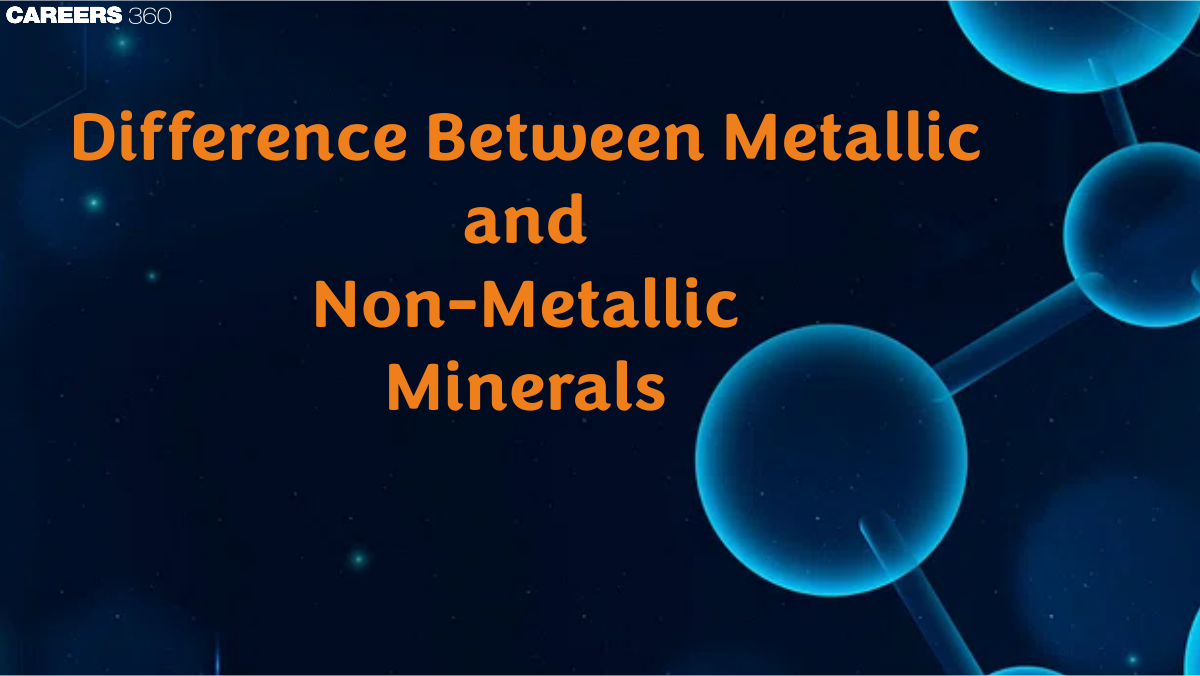Difference between Metallic and Non Metallic Minerals - Overview, Types, Examples, FAQs
Natural inorganic substances found in a variety of environments can be classified as minerals. Their chemical composition is definite, and they have a crystalline structure. Metals and non metallic minerals are two different types of minerals. Metallic minerals are conductors and non-metallic minerals basically are insulator they do not conduct electricity.
This Story also Contains
- Minerals other than metallic ones: what are they?
- Mineral types
- Minerals with energy:
- What are metallic minerals and Metallic minerals examples:
- Difference between metallic and non-metallic minerals

Minerals other than metallic ones: what are they?
A non metallic mineral is a mineral (Non-metallic mineral) that cannot be utilized for the extraction of metals . There is a huge economic significance to the group of non-metals, which is found among the variety of minerals.
Mineral types
Minerals can be classified into three types based on their composition. What they are-
Energizing mineral
Metallurgical non-metallic minerals
Minerals with energy:
Minerals that are used for energy are also called fossil fuels. Energy minerals are minerals that contain energy. Minerals that produce energy include natural gas, oil, and coal.
Also read -
| NCERT notes Class 11 Chemistry | NCERT Solutions for Class 11 Chemistry |
| NCERT notes Class 12 Chemistry | NCERT Solutions for Class 12 Chemistry |
| NCERT Notes For All Subjects | NCERT Solutions for All Subjects |
What are metallic minerals and Metallic minerals examples:
As the name suggests, metallic minerals contain metals. These metals can be obtained from the extraction of minerals. Metal minerals are often used in high-value applications, and these processes require large amounts of energy. The following are examples of iron ore and bauxite. There are two subtypes of metallic minerals. As follows:
If the metallic mineral contains ironic elements, it is referred to as a ferrous mineral.
A metallic mineral that does not contain iron elements is considered a nonferrous mineral.
What are non-metallic minerals and Non-metallic minerals examples:
As the name suggests, non-metallic minerals are found in which rocks do not consist of any metals. Diamonds, mica, salt, etc., are some examples.
Minerals can be classified into several categories. We will now explore how metallic and nonmetallic minerals differ from one another in various ways.
Minerals that are metal-based are made up of metallic elements, while non metallic minerals contain chemical elements. Non metallic minerals lack the properties or physical characteristics of metals.
Difference between metallic and non-metallic minerals
Metallic minerals are typically derived from ores, while non metallic minerals are obtained from industrial rocks and minerals. This distinction stands out when we talk about the difference between metallic and non metallic minerals. We will, however, discuss some key differences between metallic and non metallic minerals below.
The difference between metallic and non-metallic minerals | |
Metallic | Non-metallic |
Minerals containing metal elements are known as metallic minerals. | Minerals that do not contain metal substances are called non-metallic minerals. |
Metal minerals are formed when they are melted. | In the case of non-metallic minerals, such a process gives no new product. |
Metallic minerals are usually found in metamorphic and igneous rocks. | Many non-metallic minerals can be found embedded in sedimentary rocks and young fold mountains. |
Electricity and heat are well conducted by metallic minerals. | Electricity and heat are generally well-insulated by non-metallic minerals. |
The malleability and ductility of metallic minerals are very high. | Minerals with non-metallic constituents are not malleable or ductile, and these minerals break down easily. |
Metallurgical minerals are usually lustrous in appearance. | There is no shine or luster to non-metallic minerals. |
The above tables give the difference between metal and non-metal.
Also read-
Frequently Asked Questions (FAQs)
Mineral deposits containing chemical compounds or fertilizers include limestone quarries, clay pits, asphalt and bitumen deposits, peat deposits, gypsum, natural gemstones, asphalt, and other non metallic minerals other than coal and oil.
Minerals classified as metallic produce metal when they are melted. Metallic minerals possess a number of properties that make them highly beneficial and valuable. Metallic minerals have the following properties:
Heat and electricity are well conducted by metallic minerals.
Metals cannot hold electrons because they are too weak. Electrons are easily lost in them.
A metallic mineral's outer surface is shiny and hard.
Minerals in the metallic state are available at room temperature in the solid form.
Sheets and wires made from metallic minerals can be moulded and stored easily.
These are the various properties of metallic minerals.
Some common metal minerals include iron, copper, gold is metal or nonmetal, and silver. Minerals without metallic elements can be defined as having an inorganic chemical formula. The following are examples of common minerals: clay, dolomite, gypsum, mica, amethyst, quartz, etc.
As listed above, metallic elements (or short metals) possess the following properties: conduct heat and electricity. The main characteristics of these materials are that they are ductile and malevolent (i.e., they can be deformed without breaking) and usually solid at room temperature (except for mercury).
As we move down group, size increases as well as electronegativity decreases so metallic character of element increases. Thus, franium is most active metal among all.
According to the name, metallic minerals are minerals containing at least one metal. Iron, copper, silver, bauxite, manganese, and so on are great conductors of heat and electricity when they occur as mineral deposits.